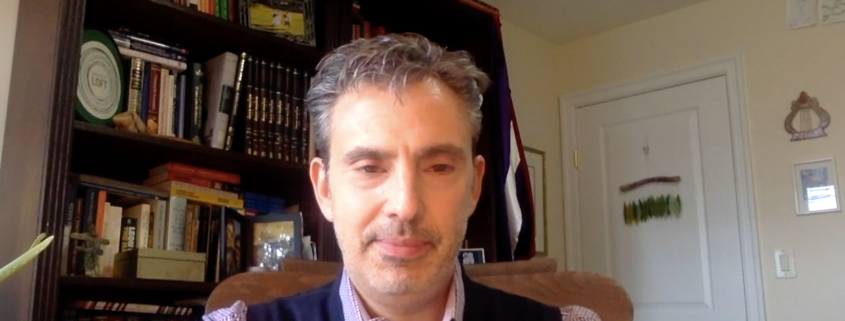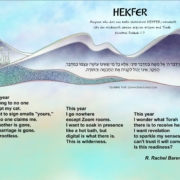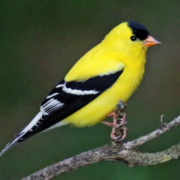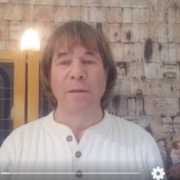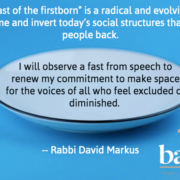Febrero 2020: Palabras del Torá / February 2020 Torah video
Palabras del Torá / a “vort” of Torah – R’ David Markus from Bayit: Building Jewish on Vimeo.
Each month Bayit offers regular video “vorts” (words of Torah / teachings from Jewish tradition) offered in or translated into Spanish, designed for Cuban Jewish communities and available to Spanish-speaking Jews everywhere. This month’s video offering features a teaching from Rabbi David Markus, translated into Spanish by Rabbi Juan Mejia. The text follows, in Spanish and then in English.
Shalom javerim – Hola amigos!
Desde mi viaje a Cuba en el otoño pasado, la profunda calidez y orgullo que tantos judíos cubanos compartieron conmigo y con mi congregación neoyorquina se ha quedado en mí y en mi corazón. Sigo inspirado por su orgullo, tenacidad y auténtica dedicación. Ustedes me enseñaron, a mí y a muchos miembros de mi congregación, una parte importante de lo que verdaderamente significa vivir como judíos.
La palabra hebrea javer (amigo) conlleva un significado más profundo, que también conlleva un importante mensaje sobre este periodo del calendario judío. Es algo que tenemos en común a pesar de las diferencia de cómo vivimos y también, precisamente, a causa de las diferencias de cómo vivimos.
La palabra hebrea javer extrae su significado profundo de la raíz trilítera ח.ב.ר. (jet, bet, reish) que significa “conectar” o “amarrar”. Los verdaderos amigos no son simples conocidos pasajeros, sino que están profundamente conectados, amarrados el uno al otro, tanto interna como externamente. De esta misma raíz verbal vienen las palabras hebreas para “unir”, “asociar”, y “pareja de estudio”. Estas son la esencia de toda comunidad.
En palabras que no puedo expresar completamente, me siento mejaber. Me siento conectado con los judíos de Cuba, parcialmente por cómo ustedes compartieron tan generosamente conmigo las conexiones entre ustedes. Inmediatamente me hicieron sentir parte de su comunidad. Ustedes saben, intuitivamente, que construir comunidad es el secreto para la supervivencia y el florecimiento judío a través de los siglos.
Esto también tiene un profundo significado en esta época del año y en las tres fiestas judías que se aproximan, una por mes, en la luna llena del mes de Febrero (Shevat), Marzo (Adar) y Abril (Nisán). Estas tres fiestas, en su esencia, también tratan de aquello que nos conecta más profundamente.
Primero viene Tu Bishvat. En el 2020 comenzará en la noche del 9 de Febrero. Coloquialmente esta fiesta es conocida como el “año nuevo de los árboles”, pero místicamente es un profundo recordatorio de que toda la naturaleza, incluídos nosotros, está unida. Lo que pasa a cualquier parte de la naturaleza, también le pasa a la totalidad. Lo que le pasa a uno de nosotros, nos pasa a todos. En la luna llena de Febrero, tomémonos el tiempo para observar cómo toda la naturaleza está conectada. Este año, al mirar a la luna llena, sabré que es la misma luna que ustedes ven y me alegraré en nuestra mutua conexión.
Después viene Purim. En el 2020 comenzará la noche del 9 de Marzo. Los niños judíos conocen a Purim como el “halloween judío”, celebrando la antigua historia de Ester y Mordejai, es un tiempo en el que nos disfrazamos para esconder nuestra verdadera identidad. Los otros dos significados profundos de Purim que más me llaman la atención tienen que ver con este aspecto de la conexión. El primero es que el destino judío sube y baja colectivamente; estamos juntos en esto, del mismo modo que los judíos persas cuya angustia y victoria la fiesta de Purim rememora. El otro es que, sin importar qué máscaras usemos en nuestras vidas, qué usemos para ocultarnos, qué hagamos para protegernos de nuestro ser más real y vulnerable, todos compartimos exactamente este impulso de auto protección. Nuestras máscaras, nuestras apariencias, no son lo que somos verdaderamente. Estamos conectados más por lo que somos internamente.
Luego viene Pesaj. En el 2020 comenzará en la noche del 8 de Abril. Conocemos a Pésaj como la historia eterna de nuestra liberación de la esclavitud- la piedra angular de nuestra identidad judía. Pésaj simboliza nuestra conexión con nuestros ancestros, por la promesa divina de nuestra liberación y por la celebración del Séder que es increíblemente similar en todo el mundo judío. También conocemos a Pésaj como un llamado moderno a la justicia. Nuestra propia liberación no será completa hasta que liberemos a todos los amarrados injustamente. Estamos conectados por este llamado judío fundamental a la justicia social, a ayudar a curar un mundo con aún demasiados faraones, aún demasiada esclavitud y demasiada vulneración de la dignidad humana.
Tu Bishvat, Purim y Pésaj. Son tres lunas llenas consecutivas de conexión. Son tres oportunidades de celebrar las conexiones entre nosotros, nuestra herencia y nuestra comunidad. Son tres oportunidades para construir comunidad- el secreto de la vida judía que ustedes bien conocen ya. Son tres oportunidades para oir el continuo llamado judío a fortalecernos y juntos vivir más enteramente- por nosotros, por la naturaleza y por toda la humanidad.
Les envio bendiciones de alegría en esta temporada con estas tres lunas llenas que nos invitan a conectarnos con la naturaleza, con la comunidad y con la libertad humana. De mi corazón para el vuestro: Jag sameaj.
Shalom javerim – Greetings, friends!
Since my trip to Cuba last fall, the deep warmth and pride that so many Cuban Jews shared with me and my New York Jewish community have stayed with me in my heart. I continue to feel inspired by your pride, tenacity and genuine caring. You have taught me, and many in the community I serve in New York, part of what it really means to live as Jews.
The Hebrew word javer (friend) encodes a deeper meaning, that also encodes something important about this season in the Jewish calendar. It’s something we have in common both despite differences in how we live, and precisely in differences in how we live.
The Hebrew word javer draws its deep meaning from the three-letter root ח.ב.ר. (jet, bet, reish), which means to connect or bind. Real friends aren’t just passive acquaintances: they are deeply connected, bound together both inside and between. From this same root word come the Hebrew words for “join,” “association,” and learning partnership. These are the essence of community.
In ways that words can’t fully express, I feel m’jaber / connected with the Jews of Cuba, partly because you so generously shared with me your connections with each other. Instantly you helped me to feel like part of your community. You know intuitively that community-building is a secret of Jewish surviving and thriving over the centuries.
This, too, is a deep meaning of this time of year and its three Jewish holidays that will follow, once per month, at the full moon of each month of February (Shevat), March (Adar) and April (Nissan). All three holidays, in their essence, also are about what most connects us.
First comes Tu B’shevat (in 2020, the night of February 9-10). Colloquially it’s the “New Year of the Trees,” but mystically it’s a deep reminder that all of nature is joined together, including all of us. What happens to any part of nature happens to the whole. What happens to any of us touches all of us. At February’s full moon, take time to notice how all of nature connects. This year, I will look up at the full moon, knowing it’s the same full moon for you, and I will revel in our connection together.
Next comes Purim (in 2020, the night of March 9-10). Jewish children might know Purim as a kind of “Jewish Halloween” celebrating the ancient story of Esther and Mordechai, a time when we dress in costume as if to conceal who we really are. Two other deep meanings of Purim that most speak to me are about connection. One is that Jewish fate rises and falls together: we’re in it together, no less than Persian Jews whose collective plight and triumph Purim honors. Another is that whatever masks we might wear in our lives, whatever conceals us, whatever we do to protect against being most vulnerable and real, we all share exactly that self-protective impulse. Our masks, our outward appearances, are not who we really are. We are most connected by what’s inside.
Then comes Passover (in 2020, starting the night of April 8). We know Passover as the timeless story of liberation from bondage – our cornerstone of Jewish identity. Passover stands for our connection by ancestry, by the divine promise of liberation, and by the seder celebration that is astonishingly similar for Jews everywhere. We also can know Passover as a modern clarion call to justice. Our own liberation will not be complete until we free all who are wrongly bound. We connect by that essential Jewish calling of social justice, to help heal a world that still has far too many Pharaohs, too much bondage, too much affront to human dignity.
Tu B’shevat, Purim and Passover. They’re three consecutive full moons of connection. They’re three opportunities to celebrate our connections to each other, heritage and community. They’re three opportunities to build community – the secret of Jewish life that you already know. They’re three opportunities to heed the continuing Jewish call to become stronger and more whole together – for ourselves, for the natural world, and for all humanity.
I send blessings of joy for this season, these three full moons that call us into our connections with nature, community and human freedom. From my heart to yours, Jag sameaj!

By Rabbi David Markus. Translated by Rabbi Juan Mejia.

